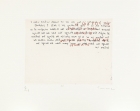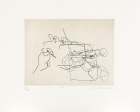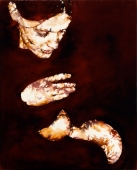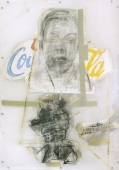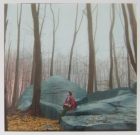
Artist | Duane Michals (*1932)
https://www.artist-info.com/artist/Duane-Michals
About the work (english / deutsch)
About the work (english / deutsch)
Duane Michals was born in Mckeesport, Pennsylvania into a typical working-class environment: his father was a steel worker and his mother a housekeeper. His interest in art began at age 14, when he began taking Saturday-afternoon watercolor classes at the Carnegie Institute in Pittsburgh. He received a B.A. from the University of Denver in 1953, and though he made a decision not to pursue a fine-arts career at that time, he developed a keen interest in the work of other artists - particularly surrealist masters such as Magritte, de Chirico and Balthus.
In 1956 he attended the Parsons School of Design in New York with thoughts of becoming a graphic designer. After just a year, however, he left and took various jobs in publishing - including working as an assistant art director for Dance magazine and as a designer in the publicity department at Time Inc.
It was during a three-week visit to Russia in 1958 that Michals first experienced his love of photography. Using a borrowed camera, he recorded a series of plain, yet elegant portraits of the people he encountered during his travels - images that would lead to his first public exhibition. In a biographical sketch in The Essential Duane Michals, author Marco Livingstone writes: "The portraits made during that trip were of the utmost simplicity and directness, successful (as he was the first to recognize) precisely because he was not setting out to be a photographer," he writes. "As soon as he saw the results, he realized that they were worth making public and that he had found his real metier."
By 1969, Michals was earning his living shooting commercially - though he has never owned a studio, or even learned to use strobe lighting. Today, to the surprise of many who only know his artistic works, he earns his living almost entirely from commercial shooting.
He has shot everything from Life covers, to fashion spreads for Vogue magazine to annual reports for the New York Times - he even shot the 'Synchronicity' album cover for the Police.
Though a master of both shooting and darkroom technique, Michals is entirely self-taught and, in fact, credits much of his success to his lack of formal training. "I was lucky because I never went to photography school and I didn't learn the photography rules," he says. "And in not learning the rules, I was free. I always say, you're either defined by the medium or your redefine the medium in terms of your needs."
Michals' role as something of an outsider and rebel seems to provide him with great amusement: "If I was concerned about being accepted, I would have been doing Ansel Adams look-a-likes, because that was easily accepted," he explains. "Everything that I did was never accepted...but luckily for me, my interest in the subject and my passion for the subject took me to that point that I wasn't wounded by that and eventually, people came around to me."
With more than 20 books of his works in print, including a retrospective entitled "The Essential Duane Michals" (Bullfinch, New York, 1997) and a book dedicated to his poetic hero, Walt Whitman entitled Salute: Walt Whitman. There is no doubt that the those who have studied his pictures have come around to see the world from the Michal's curious, often humorous, always penetrating perspective. His photographs have been shown in countless solo and group exhibitions in France, Great Britain and the United States. He has won numerous awards and his works are in major collections around the world.
"It is no accident that you are reading this. I am making black marks on white paper. These marks are my thoughts, and although I do not know who you are reading this now, in some way the lines of our lives have intersected... For the length of these few sentences, we meet here. It is no accident that you are reading this. This moment has been waiting for you, I have been waiting for you. Remember me."
Duane Michals
If there is one thing that can be said of photographer Duane Michals, it is this: he is the ultimate original.
Original in thought, in beliefs and in the execution of his images, Michals has succeeded in creating a luminous career by ignoring - in fact, defying - the established boundaries of the medium. He has spent a lifetime re-examining and re-inventing the very nature of the still photograph.
Rather than describe the outward realities that have so long fascinated photographers, Michals has turned the camera and his vision inward - confronting and attempting to describe the intangible landscapes of his own emotions, fears, dreams and desires.
"People often ask me why I was the person who came into photography and took away from it not that I was reproducing reality as found on the street, but I was going into another kind of reality," says Michals. "When I came on the scene as a photographer in the early 1960's, to be a photographer meant you could be Ansel Adams or Garry Winogrand or Robert Frank or Bresson, but my whole mental fix, the way I viewed life was really quite different than looking at life."
For Michals, that different view was fueled by an insatiable curiosity, that was not limited to people, places or things, but was much broader--pondering the very nature of existence.
Rather than describe the outward realities that have so long fascinated photographers, Michals has turned the camera and his vision inward - confronting and attempting to describe the intangible landscapes of his own emotions, fears, dreams and desires.
"Being accepted has never been an issue. I mean, it's so funny because somehow we always feel that people have to work in terms of an audience or in terms of career and all those things and, of course, if you've had the shelf life I've had, it is a career."
Duane Michals
"How foolish of me to believe that it would be that easy. I had confused the appearances of trees and automobiles and people with reality itself, and believed that a photograph of these appearances to be a photograph of it. It is a melancholy truth that I will never be able to photograph it and can only fail. I am a reflection photographing other reflections within a reflection. To photograph reality is to photograph nothing."
Duane Michals
While most photographers concern themselves with describing the physical appearance of the world around them - the people, the places, the things - Duane Michals has devoted a lifetime to describing the invisible and intangible world within his imagination.
"In my case, it's been an interior dialogue and not an exterior dialogue. The question is: 'Who am I?'," says Michals of his quest. "That's what this whole evolutionary journey has been about, with no end in sight, and that's why it's so exciting because I have to define myself."
Too many photographers, says Michals, look no farther than the surface, not only of the things they photograph, but of their own lives and emotions.
"Photographers are always photographing the package," he says. "But they would never think to open up the box. Well, I'm interested in the contents, because once you start opening up the box, it's like a Chinese box, there's always another box inside - so it's limitless."
"I am what is being experienced, the universe focused in the eye of the beholder. There is a quality of sensation felt as myself, which like the "I" of the hurricane is a calm center of the storm of awareness..."
"I'm interested in what happens when you die. I don't know how you can be alive and not question that issue - I think that is a very reasonable question"
Duane Michals
"Art is not fashionable. That's why fashion and art are two different things. Fashion can never be art because fashion deals with whim, what is temporary, what changes, what is transient, what is now and not now. Art has to deal with issues that are timeless, that never change."
Duane Michals
Another equally ethereal concept that Michals has tried repeatedly to reveal with his camera is the notion of human spirituality and enlightenment.
"I have been interested in spiritual things forever and I always will be," he says. "I'm curious about everything. I'm curious about physics, I'm curious about who's speaking, I'm curious about the very nature of my very existence - and that is illumination."
Michals' contention - and the theme of one of his more famous images "The Illuminated Man" - is that while we all possess the power of finding illumination, or an enhanced consciousness, most of us totally ignore it.
"And then I did a variation with a man dreaming in the city, too, which was, again, at night. And I simply did a time exposure. There's no trick, I mean, there's nothing else to do. Bill Brandt said all good photographs have atmosphere, I love that, and I think that these photographs have their own atmosphere."
Duane Michals
Many of Michals' more elaborate sequence images are, of course, based on real incidents that have simmered in the subconscious and been processed through the photographer's imagination. "Chance Meeting," a six-image series shot in 1970 is one of those: "I love the idea of passing somebody in the street and not being sure whether you knew them. There's kind of a moment of recognition where two people pass each other and after they're gone they turn around, and connect, but in this case the connection's too late," says Michals.
He recalls the incident that triggered the series: "I was walking down Broadway and I passed the guy up and he - and I thought, why do I know him? I had gone about a block and I realized, I think I was in the Army with him. I turned around, but he was gone. I base everything on that kind of an observation."
Many of the themes that Michals photographs and writes about are issues that require a substantial level of soul searching, both on the part of the photographer and the viewer. And very often, they present questions that are as difficult to ask as they are to try and answer: questions that can make people uncomfortable to confront.
"Sometimes it's very painful and these are issues that one eventually faces if you have any kind of a mind." It is this very uncomfortableness, these tender spots in the human psyche, that he works so hard to expose.
"What it is about is intimacy," says Michals. "It's about a kind of intimacy and privacy and whispers. What I want is that part of you that you're embarrassed about. That part of you that you don't want to tell anybody out loud." The sequence of images entitled "I Remember the Argument," is one such difficult issue that Michals himself has had to confront. The six photo series that reveals a person (whom the artist describes as a kind of "Greek chorus") standing in an empty room remembering a domestic argument that turned suddenly violent.
"My mother and father had a very disruptive marriage and I was used to seeing arguments and I was used to having periods where people didn't talk to each other and I remember those arguments," he says. "I felt that if I went back to the kitchen in the house where I was brought up and if I stood there long enough, all that kind of drama that occurred there would come back to me. It's still there in those walls, it's still there."
A master of honest and inventive portraiture, one of Michals' favorite subjects are other artists - in this case, the creative but reclusive genius Joseph Cornell, famous for his compartmentalized box creations. Interestingly, like many of Michals' (and Hans Neleman's) photos, Cornell's boxes strung together tiny bits and fragments of life's experiences to kindle much broader emotional insights. One of his greatest inspirations, Walt Whitman, has been a part of Duane Michals' life from a very young age.
"Whitman was so wonderful for me. He's one of the few people - like Magritte - who have really influenced me," he says. "When I was 17, my mother worked in a department store and I went to the bookstore and I found this copy of Leaves of Grass, which was so extraordinary. It wasn't the kind of poetry you read in high school...he addressed issues, he talked to you directly - that's where I get that talking to you directly from."
Recently, Michals published a photographic interpretation of Whitman's masterpiece Leaves of Grass entitled Tribute, Walt Whitman, which used photos of a single model throughout the book, as well as props that included a giant book with Whitman's words written in Michals' own hand.
"I wanted to get the writing, his writing, into the photographs, and I had this wonderful big book which I found at an auction in the country for two bucks," he recalls. "I would do these series where there'd be a closeup of the book and you would read the text, and the camera kept retreating and then eventually it would become a landscape...it keeps changing and then you end up with the person being diminished and he becomes part of a landscape. It was a wonderful freedom for me to get his writing inside my photographs and I'm very thrilled with that."
"Well, photographers are always photographing the package. But they would never think to open up the box. Well, I'm interested in the contents, because once you start opening up the box, it's like a Chinese box, there's always another box inside. So it is limitless. So, my version of reality means I believe in the tears, I believe in the reality of anxiety."
Duane Michals
"I wrote a little essay in my portrait book called 'I'm much nicer than my face' - If you never saw me before and you take one look at this guy, and you think, well, he's an older guy you know nothing about me, and and it would be interesting to hear what you would invent about me - 'Who is this guy?' I'm much more interesting than anything you could possibly come up with. I'm an extremely interesting person. You'll never see it looking at me."
Duane Michals
"Photographers tend not to photograph what they can't see, which is the very reason one should try to attempt it. Otherwise we're going to go on forever just photographing more faces and more rooms and more places. Photography has to transcend description. It has to go beyond description to bring insight into the subject, or reveal the subject, not as it looks, but how does it feel?"
Duane Michals
"How could it be that one day I will say goodbye to all of this and miss the lilac spring, the May times whistling on the wing, and the robin's kiss? In the summertime, when days and evenings are in rhyme, you will not find me in the grove among the lilies in repose or weeding in the garden path where scented seedlings hold on fast. When autumn falls I'll cast no shadow on the wall or hear the owl's haunted hoot high above the rotting root. When all is orange russet red I will not be with you in bed.
The day the silent snow descends and lolls to sleep all living friends, I too will slumber in the earth among the seeds and squirrel's birth. Who will miss me? Who will care? When I am called and no one's there?"
Duane Michals
Fotografien 1958 - 1998
Vom 22. Juni bis zum 30. Juli 2000 zeigt das Fotografie Forum International (Frankfurt am Main) eine Ausstellung mit 70 Werken des amerikanischen Künstlers Duane Michals, aus den Jahren 1958 bis 1998, die von Enrica Vigano (Madrid / Mailand) für das Fotografie Forum international kuratiert wurde.
Kennzeichnend für Duane Michals ist, dass er, als Künstler und Poet, die Kamera nicht dazu benutzt, ein Abbild der Wirklichkeit zu schaffen. Vielmehr geht es ihm darum, Grenzen zu überschreiten und Wirklichkeit und Traum verschmelzen zu lassen. Er selbst erklärte einmal: "Ich glaube an das Unsichtbare. Ich glaube nicht an das Sichtbare ( ... )" Ein anschauliches Beispiel dafür sind Bildtitel wie "Now becoming then" (1978) und "All Things Mellow in the Mind" (1986), worin sich auch sein Neigung zum Surrealismus offenbart.
Schon früh erkennt er, dass es nicht seinem Naturell entspricht, in der Tradition eines Henri Cartier Bresson zu arbeiten, denn er ist, nach eigenem Bekunden, zu zögerlich beim Festhalten des "entscheidenden Moments". Seine Welt ist die der Inszenierung ausgedachter oder arrangierter Elemente und in Anbetracht der Tatsache, dass auch die authentischsten Dokumentarfotografien gestellt sein können, erscheint es ihm nur ehrlich, dies auch von Anfang an klarzustellen.
Intensiv experimentiert er seit den fünfziger Jahren mit den technischen Möglichkeiten der Fotografie, wie Mehrfachbelichtung, Schärfe und Unschärfe, Bewegung und Montage. In den sechziger Jahren setzt er sich als erster über die Beschränktheit des Einzelbildes hinweg und stellt aus bis zu 15 Aufnahmen narrative Bildsequenzen zusammen, die von geheimnisvollen, oft nicht auf den ersten Blick zu entschlüsselnden, Geschehnissen erzählen, in der der Phantasie des Betrachters keine Grenzen gesetzt sind.
Duane Michals Arbeiten handeln von den großen menschlichen Themen: Sexualität, Tod und Spiritualität. Trotz des oft ernsten Hintergrundes, sind seine Arbeiten selten schwermütig sondern besitzen meist ein humorvolles Moment.
Später beginnt er, seine Fotografien auch mit handgeschriebenen Texten zu versehen und erweitert somit ihre künstlerische Aussage und ihren Erkenntniswert über die Komplexität des menschlichen Seins. Es sind ganz besonders diese Bild- und Textkompositionen, die ihm zu seiner Berühmtheit verhalfen und ihn zu einer Ikone der zeitgenössischen Fotografie werden ließen.
Duane Michals wurde 1932 in McKeesport, Pennsylvania, als Sohn des Stahlarbeiters Ambrose Michals und der Haushälterin Margaret Matik geboren. Aufgezogen wird der Junge in den ersten Jahren von seiner tschechischen Großmutter, die um die Jahrhundertwende nach Amerika ausgewandert war. Wie nachhaltig ihn diese frühen Eindrücke und die fremde Herkunft geprägt haben, verdeutlicht die spätere Erfindung eines Alter egos namens Stefan Mihal. Mihal verkörpert das, was er hätte werden sollen: ein verheirateter Fabrikarbeiter mit Kindern, der ein bescheidenes und unauffälliges Dasein in einer Vorstadt fristet. Mihal firmiert als Schöpfer und Objekt in den Selbstportraits des Künstlers sowie als Herausgeber des Photobandes "Take One and See Mt. Fujiyama".
1953 erhält er sein Bachelor of Arts von der University of Denver. Nach dem College wird er eingezogen und dient als Panzerleutnant in Deutschland, u.a. auch in Frankfurt. 1959 nimmt er mit Portraitstudien, die während einer dreiwöchigen Reise in die Sowjetunion, mit einer geliehenen Kamera entstanden sind, an seiner ersten Gruppenausstellung in der kleinen New Yorker Image Gallery teil. Von da an beschließt er, sich ausschließlich auf die Fotografie zu konzentrieren. In den 60er Jahren arbeitet er sehr erfolgreich für die großen Hochglanzmagazine, was ihm die finanzielle Möglichkeit gibt, sich auf das, was ihm am Herzen liegt, sein privates Werk, zu konzentrieren.
Fotografien von Duane Michals wurden in Ausstellungen von internationalem Rang präsentiert, u.a. mit Retrospektiven in Frankreich, England und den USA und er veröffentlichte zahlreiche Bücher mit Fotografien und Texten.
Zu dieser Ausstellung ist das Buch "Duane Michals – Werkübersicht", 1997, Schirmer/Mosel Verlag, im Fotografie Forum international erhältlich. Preis: DM 49,80.
Bibliography
Bibliography
Duane Michals – Werkübersicht, 1997, Schimer / Mosel Verlag
Sarane Alexandrian, Surrealist Art, Thames & Hudson, 1970.
P. Paton. "Captioned pictures, pictures captioned: Museum of Modern Art", Exhibit, Art News Jan 1977, p109. Illustration: Sailor in Minsk.
M. Hayholt. "Festival D'arles", L'Oneil Sept. 1976, P.53. Illustration: Black is Ugly
J. Perrone. "Self as Apparition" Artforum, Jan 1977, p.22-7. Illustrations: Something Strange is Happening, Chance Meeting, Portrait of David Hemmings, This Photograph is my Proof, Take one and See, Mt. Fujijama, People Eat People.
Sidney Janis Gallery, NY Exhibit, Arts Magazine, Dec. 1976, p. 30. Illustration: Letter from my Father.
Sidney Janis Gallery, NY Exhibit, Arts Magazine, Dec. 1976, p. 25. (J. Crary) Illustration: Bill Brant (portrait).
Repro: Captive Child, Arts Mag, Oct. 76, p. 38. Illustration: Chance Meeting.
Repro: Certain words must be said, Arts News, Oct. '76, p. 104. Fashion photo.
Texas Center for Photographic Studies, Art News, April '76
Repro: Alice's Mirror (1971), Artforum, Feb. '76, p.79.
Photography a Contemporary Compendium: Biography, Camera, Dec. 1975, p.43. Illustrations.
Duane Michals: People and Places, Print, March 1966, p. 28-33, Illustrations & portraits.
Sequences; still photography relating events and sequences, Camera, Feb. 1971. Illustrations.
D. Palaggoli "Fotografie, le sequence di Duane Michals alla Gallaria di Fotographia", Dominus, No.530, Jan. 1974, p.51-3. Illustrations & portraits.
A. Grundberg, "Duane Michals at Light" Art in America, May 1975, p.78-9. Illustration Self Portrait w/ my Guardian Angel
 offers / Requests offers / Requests  |
About this service |
|---|
 Exhibition Announcements Exhibition Announcements  |
About this service |
|---|
 Visualization |
Learn more about this service | ||
|---|---|---|---|

Interested in discovering more of this artist's networks?
3 easy steps: Register, buy a package for a visualization, select the artist.
See examples how visualization looks like for an artist, a curator, or an exhibition place: Gallery, museum, non-profit place, or collector.

Exhibition History

|
SUMMARY based on artist-info records. More details and Visualizing Art Networks on demand. Venue types: Gallery / Museum / Non-Profit / Collector |
||||||||||||
| Exhibitions in artist-info | 103 (S 35/ G 68) |
Did show together with - Top 5 of 1210 artists (no. of shows) - all shows - Top 100
|
||||||||||
| Exhibitions by type | 103: 39 / 42 / 22 / 0 | |||||||||||
| Venues by type | 74: 19 / 34 / 21 / 0 | |||||||||||
| Curators | 33 | |||||||||||
| artist-info records | Oct 1970 - May 2024 | |||||||||||
|
Countries - Top 5 of 8 United States (49) Germany (31) France (9) Denmark (4) Switzerland (3) |
Cities - Top 5 of 41 New York (32) Paris (8) Düsseldorf (7) Köln (6) Berlin (5) |
Venues (no. of shows )
Top 5 of 74
|
||||||||||
Curators (no. of shows)
Top 5 of 33
|
| Museum Kunstpalast | G | Feb 2024 - May 2024 | Düsseldorf | (82) | +0 | |
| Conze, Linda (Curator) | +0 | |||||
| Museum für Fotografie | G | Feb 2016 - Jun 2016 | Berlin | (21) | +0 | |
| Kunstmuseum Bonn | G | Jun 2014 - Sep 2014 | Bonn | (181) | +1 | |
| Gronert, Stefan (Curator) | +0 | |||||
| Elke Dröscher Kunstraum Falkenstein | G | Feb 2014 - Apr 2014 | Hamburg | (30) | +0 | |
| NRW-Forum Kultur und Wirtschaft | S | Jan 2014 - Mar 2014 | Düsseldorf | (51) | +0 | |
| Palais de Tokyo | G | Jun 2013 - Sep 2013 | Paris | (44) | +0 | |
| Boukobza, Julie (Curator) | +0 | |||||
| Castets, Simon (Curator) | +0 | |||||
| Trezzi, Nicola (Curator) | +0 | |||||
| Keep reading |














